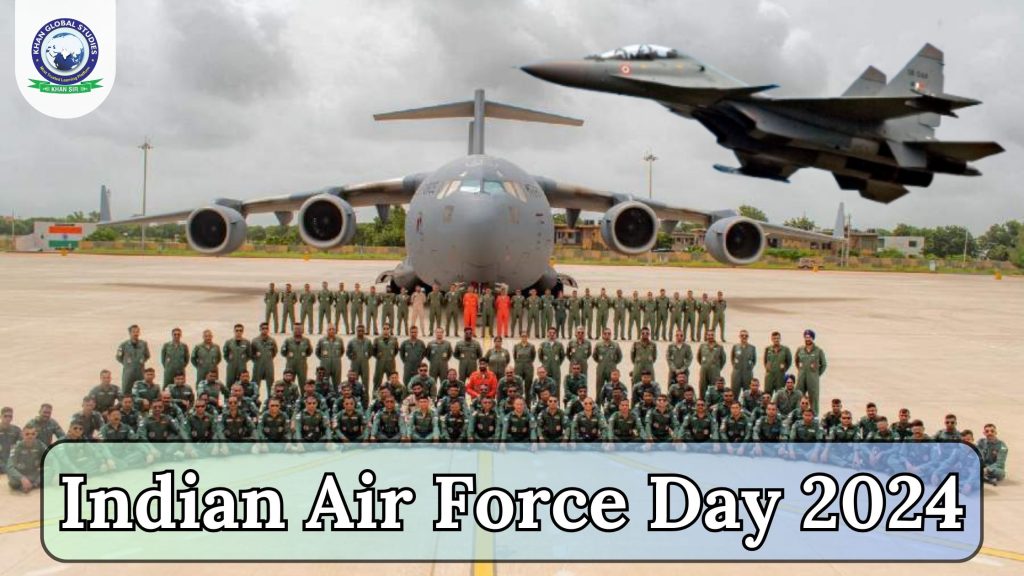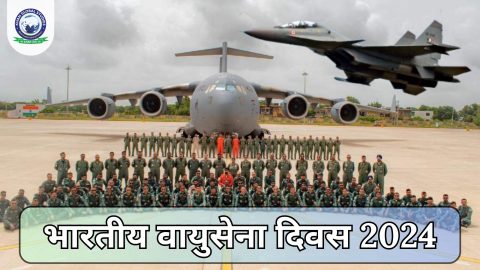The Indian Air Force Foundation Day is celebrated every year on October 8. It was officially established on October 8, 1932, as the Royal Air Force (RAF) auxiliary air force under the British Empire. Initially, it had a small number of personnel and aircraft, but over the decades it has become one of the strongest air forces in the world.
Introduction
The Indian Air Force (IAF) is the air arm of the Indian Armed Forces. Its main purpose is to protect Indian airspace and conduct aerial combat in times of war. The Indian Air Force was formed on 8 October 1932 as an auxiliary air force of the British Empire. It got the nickname “Royal” during World War II. After India’s independence, it was called the “Royal Indian Air Force”, but when India became a republic in 1950, the word “Royal” was dropped.
Since 1950, the Indian Air Force has taken part in four wars with Pakistan. Apart from this, it has also been involved in important military actions like Operation Vijay, Operation Meghdoot, Operation Cactus and Operation Poomalai. Apart from this, the IAF also participates in United Nations peacekeeping missions.
The President of India is the supreme commander of the Indian Air Force. As of 1 July 2017, the Indian Air Force had 1,70,576 personnel.
The head of the Indian Air Force, the Air Chief Marshal, is a four-star officer who is responsible for the Air Force’s operations. The IAF has only one Air Chief Marshal at a time. Only once, on 26 January 2002, has Arjan Singh been given the five-star rank of “Marshal of the Air Force.”
The day is celebrated to acknowledge the bravery, sacrifices and achievements of the Indian Air Force in defending the nation. The IAF has played a vital role in various wars and peace missions, contributing significantly to India’s national security.
History and War
Formation and Initial Pilots
The Indian Air Force (IAF) was established on 8 October 1932 as an auxiliary unit of the “Royal Air Force” during British rule. It was recognised under the Indian Air Force Act of 1932 and adopted the uniform, badges and insignia of the Royal Air Force.
On 1 April 1933, the first squadron of the IAF, No. 1 Squadron, was raised with four Westland Wapiti biplanes and five Indian pilots. These pilots were led by British officer Flight Lieutenant Cecil Bouchier, who later became an Air Vice Marshal.
The Indian Air Force has played a significant role in various conflicts and wars, including:
- Indo-Pak Wars (1947, 1965, 1971, 1999 – Kargil): The IAF provided air superiority and close air support during these wars, most notably the 1971 war that led to the creation of Bangladesh.
- 1962 Sino-Indian War: Although the IAF was not heavily involved in the war, it played a vital role in transportation and logistics.
- Kargil War (1999): The Indian Air Force conducted airstrikes in Operation Safed Sagar, helping India gain control of key bases in the Kargil sector.
- Balakot Air Strike (2019): The Indian Air Force conducted airstrikes on terror camps in Pakistan in response to the Pulwama terror attack.
World War II (1939–1945)
During World War II, the IAF played a key role in halting the advance of the Japanese army in Burma. The first air attack of the IAF was on the Japanese military base in Arakan. Thereafter, the IAF continued to attack Japanese airbases in northern Thailand.
The IAF was mainly involved in strikes, close air support, aerial reconnaissance, bomber escort and other missions. IAF and RAF pilots were trained together to gain combat experience and better communication skills. IAF pilots took part in air operations in Burma as well as in North Africa and Europe.
Apart from the IAF, many Indians and about 200 Indians living in Britain volunteered in the RAF and the Women’s Auxiliary Air Force (WAAF). One of them was Sergeant Shailendra Eknath Sukthankar, who served in the RAF and was awarded the DFC in 1943. Another volunteer was Noor Inayat Khan, an Indian nationalist and Muslim pacifist. She joined the WAAF and fought against Nazism, but was caught serving as a spy in France.
During the war, the IAF expanded rapidly and its fleet included many new aircraft, such as the Vultee Vengeance, Douglas Dakota, Hawk Hurricane, Supermarine Spitfire and Westland Lysander.
In 1945, in recognition of the IAF’s bravery, King George VI granted it the nickname “Royal”, becoming known as the Royal Indian Air Force.
First Years of Independence (1947–1950)
After independence from the British Empire in 1947, India and Pakistan became two new countries. Along with this, the assets of the Air Force were also divided. India’s Air Force was named Royal Indian Air Force (RIAF), while 3 of the 10 squadrons and some facilities were transferred to Pakistan, which now became the Royal Pakistan Air Force.
At the same time, a conflict began between India and Pakistan over the control of Jammu and Kashmir. After Pakistani forces entered the state, the Maharaja signed the Instrument of Accession to receive assistance from India. Soon after, the RIAF took on the task of transporting Indian troops to the battle area, which led to war, although no formal war was declared. In this war, the RIAF did not have direct air combat with the Pakistani Air Force, but Indian aircraft tried to intercept Pakistani aircraft. In addition, the RIAF also provided transport and air support to the Indian Army.
When India became a republic in 1950, the word “Royal” was dropped and it came to be called the Indian Air Force (IAF).
Congo Crisis and Annexation of Goa (1960–1961)
In 1960, the Indian Air Force (IAF) participated in significant combat for the first time during the Congo Crisis. Violence and rebellion escalated in the Congo following the end of 75 years of Belgian rule. The IAF’s No. 5 Squadron, equipped with English Electric Canberra aircraft, was sent to support the UN mission. They began operations in November 1960 and remained stationed there until 1966. These aircraft destroyed the rebel air force and provided long-range air support to the UN ground forces.
In late 1961, following a dispute between India and Portugal over Goa, the Indian government decided to attack Goa. The operation was named Operation Vijay. On 18 December, Indian Air Force Canberra bombers bombed the runway of the Dabolim airport but did not damage the terminal and the ATC tower. Some Portuguese aircraft escaped, while the rest were captured. In addition, Hunter and Vampire aircraft provided air support to the ground forces.
Border disputes and changes in the Indian Air Force (1962–1971)
In 1962, the border dispute between China and India turned into a war of attrition when China sent its troops across the border. During this war, the Indian Army did not use the Indian Air Force (IAF) properly, which caused losses to India, especially in Jammu and Kashmir.
In 1965, Pakistan launched Operation Gibraltar, which aimed to challenge India’s rule by revolting in Jammu and Kashmir. This is called the Second Kashmir War. In this war, for the first time, the IAF directly encountered an enemy air force. Although the IAF attacked the PAF, these attacks were risky as they were in the lowest echelons of Pakistan. The PAF had a technological edge, but the IAF prevented it from gaining air dominance. The IAF’s smaller and faster Folland Gnat fighters gave the PAF’s F-86 Sabre fighter the nickname “Sabre Slayers”.
After the war, the IAF made several changes to regain its strength. In 1966, the Para Commando Regiment was formed. The IAF inducted the HS 748 Passat manufactured by Hindustan Aeronautics Limited (HAL). Along with this, the IAF began to focus on indigenous aircraft manufacturing, with the HAL HF-24 Maruti and HAL joining the group.
Bangladesh Liberation War (1971)
In late 1971, the independence movement in East Pakistan intensified, leading to the Bangladesh Liberation War. On November 22, four F-86 Sabre jets of other aircraft attacked Indian and Liberatory battalions, killing two jets IAF Kland Fogan. On December 3, India declared war on Pakistan. In the first two Ukrainian, the IAF flew about 12,000 flights and supported the Indian Army. By the end of the war, the IAF destroyed 94 PAF aircraft and guaranteed the independence of Bangladesh. Pakistan suffered major losses, while India suffered less losses.
Kargil War (1999)
Introduction: The Kargil War took place between India and Pakistan in 1999. This conflict was fought in the high mountainous regions of Kashmir. The Indian Air Force (IAF) played an important role in it.
Main Events:
- Operation Safed Sagar:
- On 11 May 1999, the Indian Air Force was called in to provide close air support for the Indian Army.
- The first attacks began on 26 May, when the IAF attacked the infiltrators’ positions.
- Aircraft Deployment:
- The IAF used MiG-27 and MiG-21 aircraft. MiG-29s provided cover.
- The Srinagar airport was closed for civilian flights at that time and was dedicated to the IAF.
- First Losses:
- On 27 May, the IAF lost a MiG-21 and a MiG-27.
- On 28 May, a Mi-17 helicopter was shot down by Stinger missiles, killing four crew members.
- Use of Mirage 2000:
- On 30 May, the use of Mirage 2000 aircraft began, which were capable of better performance at high altitudes.
- The Mirage 2000s successfully attacked enemy positions and disrupted supply lines.
- Flights and Achievements:
- During the war, the IAF flew over 40 sorties daily.
- On 26 July 1999, Indian forces successfully pushed back Pakistani forces in Kargil.
Post-War Events (1999–Present)
- Modernisation:
- Since the late 1990s, the IAF has focused on modernising its fleet.
- In this period, the number of IAF squadrons has declined to 33.
- Missiles and surveillance:
- On 10 August 1999, IAF MiG-21s intercepted a Breguet Atlantique of the Pakistan Navy.
- On 2 August 2002, the IAF bombed Pakistani posts in the Kel sector of Kashmir.
Specific Events:
- Landing of C-130J:
- On 20 August 2013, the IAF set the record for the world’s highest landing at the Daulat Beg Oldi airstrip.
- 2019 Pulwama Attack:
- Following the Pulwama attack in 2019, the IAF carried out airstrikes on Jaish-e-Mohammed hideouts in Balakot.
- India-Pakistan Standoff:
- On 27 February 2019, an encounter took place between IAF aircraft and the Pakistan Air Force.
- An Indian MiG-21 was shot down, but the pilot managed to eject safely.
Conclusion: The Kargil War brought about significant changes in the capabilities and operations of the Indian Air Force. Today, the IAF is the fourth largest air force in the world, equipped with the most modern aircraft.
Facts
Know some facts about the Indian Air Force:
- Su-30MKI feat – Su-30MKI aircraft can perform the Pugachev’s Cobra feat, an amazing aerial stunt to evade enemy attacks.
- Operation Safed Sagar – During the 1999 Kargil War, the Indian Air Force launched Operation Safed Sagar to secure vital locations in Jammu and Kashmir.
- Fourth Largest Air Force – The Indian Air Force is the fourth largest air force in the world, with over 1,700 aircraft and employing around 1,40,000 personnel.
- World’s Highest Airstrip – The Indian Air Force operates the world’s highest airstrip at Daulat Beg Oldie in Ladakh, located at an altitude of 16,614 feet.
- Hero in Space – Wing Commander Rakesh Sharma was the first Indian to go to space in 1984. He said about India, “Saare Jahan Se Achcha,” when asked what India looks like from space.
- Women Fighter Pilots – The Indian Air Force is the first Indian military branch to induct women into combat roles. In 2016, Avani Chaturvedi, Bhawana Kanth and Mohana Singh became the first female fighter pilots.
- Humanitarian Missions – The Indian Air Force has helped rescue people and deliver relief materials during disasters, such as the Uttarakhand floods, when 382,400 kg of relief material was delivered using 45 helicopters.
- Netra AEW&C – Netra is the airborne early warning and control system of the Indian Air Force, which enhances surveillance and reconnaissance capabilities.
- Combat Air Transport with Il-76 – The Indian Air Force is the only air force in the world that uses the Ilyushin Il-76 for combat air transport, which plays a vital role in moving troops and equipment.
- Garud Commando Force – The Garud Commando Force is the special forces unit of the Indian Air Force, trained for counter-terrorism operations, rescue missions and other special operations. They set an amazing example of staying calm under pressure.
- Size – The Indian Air Force (IAF) is the fourth largest air force in the world, with over 1,700 aircraft and over 1,40,000 personnel.
- Role in Wars – The Indian Air Force has participated in many wars, including the wars with Pakistan in 1947-1948, 1965, 1971, and 1999. Apart from this, the Air Force also provided air support in the 1962 war with China.
Other Achievements:
The Indian Air Force has achieved many other significant achievements, such as:
- Supporting the merger of Goa with India in 1961
- Capturing the Siachen Glacier in 1984
- Operating the world’s highest airstrip
- Successfully executing Operation Rahat, a major humanitarian mission
- Inducting women into combat roles.
Target
The mission of the Indian Air Force is defined by the Armed Forces Act 1947, the Indian Constitution and the Air Force Act 1950. Its primary purpose is to protect India and its airspace, especially during wartime, and to ensure smooth evacuation of troops after a war.
Indian Air Force Objective
- Defence: Protecting India’s airspace from enemies in collaboration with the Indian Army and Navy.
- Relief: Assisting the civil administration in times of natural disasters and internal problems.
- Air Support: Providing air support to the Indian Army in the battlefield.
- Airlift Capability: Facilitating strategic and tactical airlift for the military.
- Space and Relief Missions: The Indian Air Force works closely with the Indian Army, Department of Space and ISRO under the Integrated Space Cell, enabling civil and military cooperation in the space sector.
The IAF has also played a vital role in several relief operations, such as the 1998 Gujarat cyclone, the 2004 Tsunami, and the 2013 North India floods. In addition, the IAF has also been involved in overseas relief missions such as Operation Rainbow in Sri Lanka.
Role of Indian Air Force
The Indian Air Force plays a vital role in keeping India’s skies and its territory safe from external threats. Its primary functions include:
- Air Defence: Defending Indian airspace against enemy attacks and infiltration.
- Aerial Warfare: Engaging enemy aircraft and providing air support during conflicts and wars.
- Tactical and Strategic Airlift: Carrying troops, equipment and supplies during operations and humanitarian missions.
- Disaster Relief and Humanitarian Assistance: Providing assistance during natural disasters and conducting rescue missions.
- Peacekeeping Missions: Supporting international peace efforts under the United Nations or other coalitions.
- Surveillance and Reconnaissance: Monitoring activities within Indian territory and its borders.
The motto of the Indian Air Force
The motto of the Indian Air Force is “Nabhah Sprisham Deeptam” which translates to “Touch the skies with glory”. This powerful phrase is taken from the Bhagavad Gita, Chapter 11, Verse 24, where Lord Krishna shows his divine form. This motto reflects the power and valour of the Indian Air Force, highlighting its ability to dominate the skies while maintaining dignity and honour.
First Chief of the Air Staff
The first Chief of the Air Staff of the Indian Air Force was Air Marshal Subroto Mukherjee, who took over in 1954. He is often regarded as the “Father of the Indian Air Force” for his efforts in building the force during its formative years. Under his leadership, the IAF expanded its fleet and acquired modern capabilities.
Air Shows
The Indian Air Force conducts spectacular air shows as part of the Air Force Day celebrations. These air shows are held at various IAF stations, the most notable being Hindon Air Force Station near Ghaziabad in Uttar Pradesh.
- Past Air Shows: In the past, these air shows included awe-inspiring formations, aerobatics by aircraft such as the Sukhoi Su-30MKI, Tejas, Jaguar and MiG-21, and performances by the Sarang Helicopter Display Team and the Surya Kiran Aerobatic Team. These air shows showcase the skill and professionalism of the IAF pilots.
- 2023 Air Show: At the 2023 Indian Air Force Day celebrations, the air show included flypasts of fighter jets, helicopters and transport aircraft. The chief guest of the event was President Draupadi Murmu, the supreme commander of the Indian armed forces. The air show also highlighted indigenous advancements, with aircraft like the Tejas and Rafale making headlines.
Conclusion
The Indian Air Force Day is a celebration of the courage, commitment and valour of the Indian Air Force. Over the decades, the IAF has transformed into a formidable force, capable of handling modern warfare while ensuring the security of the nation. Through its involvement in wars, peacekeeping missions and humanitarian efforts, the IAF has lived up to its glorious motto, “Touch the Skies with Glory”.



